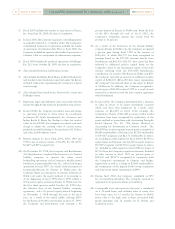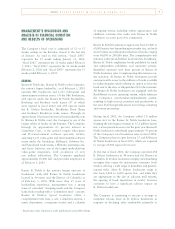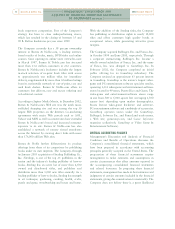Barnes and Noble 2002 Annual Report Download - page 19
Download and view the complete annual report
Please find page 19 of the 2002 Barnes and Noble annual report below. You can navigate through the pages in the report by either clicking on the pages listed below, or by using the keyword search tool below to find specific information within the annual report.
financing continue to provide the Company with liquidity
and capital resources for store expansion, seasonal
working capital requirements and capital investments.
In February 2002, the Company completed an initial
public offering (IPO) for its GameStop subsidiary, raising
$250.0 million in cash for the Company (which was used
to pay down debt) and $98.0 million in net proceeds for
GameStop. The Company has retained an approximate
63 percent interest in GameStop.
Cash Flow
Cash flows provided from operating activities were
$329.0 million, $457.4 million and $80.5 million
during fiscal 2002, 2001 and 2000, respectively. In
fiscal 2002, the decrease in cash flows from operating
activities was primarily attributable to a weaker-than-
expected holiday season, as well as the increase in
inventory due to the Reno distribution center becoming
fully operational. In fiscal 2001, the increase in cash flows
from operating activities was primarily attributable to
increased accounts payable leverage and improvement
in net earnings. In fiscal 2000, the decrease in cash flows
from operating activities was primarily attributable to
a weaker-than-expected holiday season which resulted
in lower net earnings and an increase in standing
inventory as well as an increase in prepaid rent due to
the fiscal year-end date.
Retail earnings before interest, taxes, depreciation and
amortization (EBITDA) increased $0.9 million or 0.2%
to $393.1 million in fiscal 2002 from $392.2 million in
fiscal 2001. Total debt to retail EBITDA improved to
0.76 times in fiscal 2002 from 1.14 times in fiscal 2001,
primarily due to decreased borrowings under the
Company’s senior credit facility. The reduced debt, which
was accomplished during a period of 8.2% sales growth
and an 8.6% increase in merchandise inventories, was
primarily attributable to the proceeds received from the
GameStop IPO. The weighted-average age per square
foot of the Company’s 628 Barnes & Noble stores was
5.8 years as of February 1, 2003 and is expected to
increase to approximately 6.5 years by January 31, 2004.
As the Barnes & Noble stores continue to mature, and as
the number of new stores opened during the fiscal year
decreases as a percentage of the existing store base, the
increasing operating profits of Barnes & Noble stores are
expected to generate a greater portion of the cash flows
required for working capital, including new store
inventories, capital expenditures and other initiatives.
Since the fiscal 1999 Barnes & Noble.com Inc. IPO,
retail cash flows have been fully available to support the
Company’s working capital requirements. In the future,
the Company may provide additional funding to Barnes
& Noble.com. As of February 1, 2003, the Company
had an aggregate receivable of $55.2 million from Barnes
& Noble.com related to its supply and service agreements.
Barnes & Noble.com had cash, cash equivalents and
short-term marketable securities of $70.1 million as of
its year ended December 31, 2002, an amount sufficient
to cover this payable due to the Company.
Capital Structure
Strong cash flows from operations and a continued
emphasis on working capital management strengthened
the Company’s balance sheet in fiscal 2002. Shareholders’
equity increased 15.7% to $1.028 billion as of February
1, 2003, from $888.1 million as of February 2, 2002.
In fiscal 2002, the Company obtained a $500.0 million
three-year senior revolving credit facility (the Facility)
with a syndicate of banks led by Fleet National Bank as
administrative agent. The Facility, which expires in May
2005, replaced the Company’s $850.0 million senior
credit facility. The Facility permits borrowings at various
interest-rate options based on the prime rate or London
Interbank Offer Rate (LIBOR) plus applicable margin
depending upon the level of the Company’s fixed charge
coverage ratio. The Company’s fixed charge coverage is
calculated as the ratio of earnings before interest, taxes,
depreciation, amortization and rents to interest plus
rents. In addition, the Facility requires the Company to
pay a commitment fee of 0.25 percent, which fee varies
based upon the Company’s fixed charge coverage ratio,
calculated as a percentage of the unused portion. The
Company is required to pay utilization fees of 0.125
percent or 0.25 percent on all outstanding loans under
the Facility if the aggregate outstanding loans are greater
than 33 percent and 66 percent, respectively, of the
aggregate amount of the Facility.
Aportion of the Facility, not to exceed $100.0 million, is
available for the issuance of letters of credit. Also, under
certain circumstances, the Company may be permitted to
increase the size of the Facility to an amount not to
exceed $600.0 million and/or to extend the term of the
Facility by one additional year.
The amount outstanding under the Facility has been
classified as long-term debt in the accompanying
[MANAGEMENT’S DISCUSSION AND
ANALYSIS OF FINANCIAL CONDITION AND RESULTS
OF OPERATIONS continued ]
18
2002 Annual ReportBarnes & Noble, Inc.
























